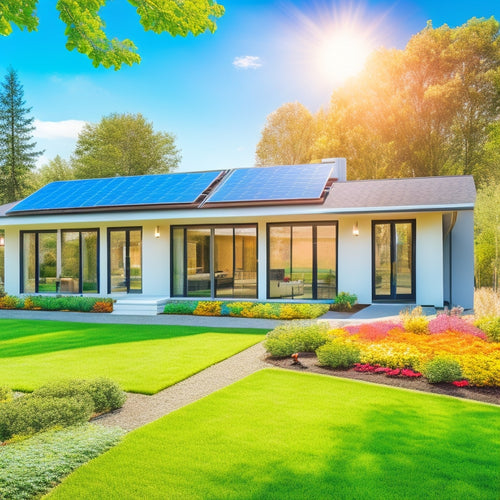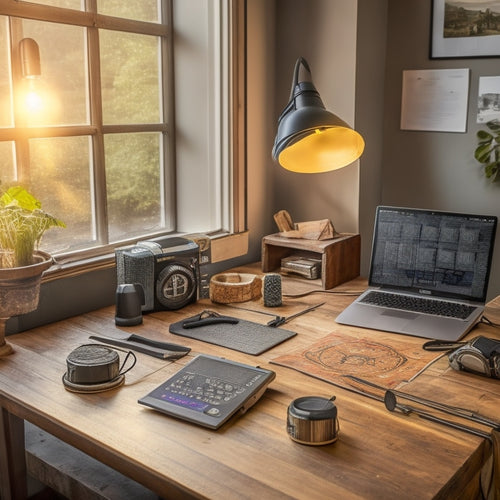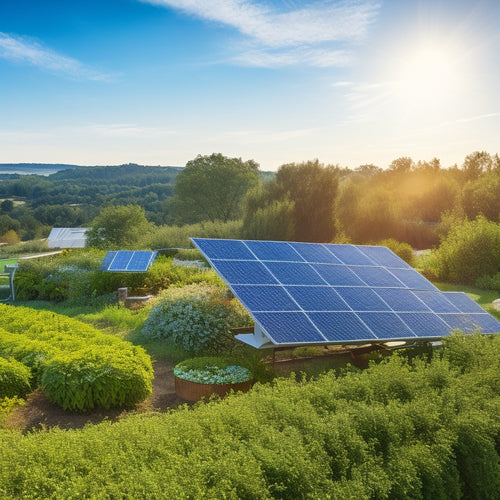
7-Step DIY Solar Roof Panel Installation Process
Share
You'll begin by checking your roof's sunlight exposure, energy consumption, and regulatory compliance, ensuring your solar panel system meets your needs and local codes. Next, you'll prepare your roof by inspecting for cracks, clearing debris, and evaluating structural integrity. Then, you'll install a mounting system, followed by solar panel installation, electrical connection, and configuration. After that, you'll focus on safety precautions, wiring techniques, and testing procedures. Finally, you'll conduct a final inspection and activation, verifying all connections and systems. As you maneuver through these intricate steps, you'll uncover the subtleties of a successful DIY solar roof panel installation.
Key Takeaways
- Ensure your roof is suitable for solar panels by assessing sunlight exposure, energy consumption, and local building codes.
- Prepare your roof by inspecting for damage, clearing debris, and evaluating its structural integrity to support the solar panel weight.
- Choose the appropriate mounting system for your roof type, considering factors such as flexibility, installation ease, and weight distribution.
- Install solar panels and electrical components according to manufacturer's instructions, following safety protocols and local electrical codes.
- Conduct thorough testing and inspections to ensure the system is functioning correctly and safely before activation.
Pre-Installation Checklist
Before diving into the installation process, take a moment to review this essential pre-installation checklist to guarantee a smooth and successful DIY solar roof panel installation.
You've likely considered the solar panel benefits, such as reducing your carbon footprint and saving on energy bills. Now, it's vital to confirm you're prepared for the installation process.
First, verify that your roof receives sufficient sunlight. Shading from trees or buildings can greatly impact your solar panel system's performance.
Next, assess your energy consumption to determine the ideal system size for your needs. This will help you optimize your energy output and maximize your savings.
Additionally, research local building codes and permits required for your installation. Failing to comply can result in costly fines or even removal of your system.
Roof Preparation and Inspection
You'll need to assess your roof's condition to guarantee it can support the weight of the solar panels and withstand environmental elements.
Start by checking for damaged, missing, or loose roofing materials, such as shingles, tiles, or flashing, and make repairs as necessary.
You'll also need to verify your roof's structural integrity by inspecting the underlying structure, including rafters, trusses, and sheathing, to guarantee it can handle the added load.
Roof Condition Assessment
Your roof's structural integrity and surface condition play a critical role in determining the success of your DIY solar roof panel installation project. A thorough roof condition assessment is essential to identify any potential issues that could affect the performance and longevity of your solar panel system.
Before proceeding with the installation, inspect your roof for:
-
Cracks and gaps: Look for any cracks or gaps in the roofing material, flashing, or around chimneys, vents, and skylights. These openings can allow water to seep in and compromise the roof's integrity.
-
Loose or missing shingles: Check for loose, missing, or damaged shingles that can create pathways for water to enter and cause damage.
-
Debris and vegetation: Clear your roof of debris, such as leaves, branches, and moss, which can obstruct the installation process and affect the solar panels' performance.
- Signs of wear and tear: Inspect for signs of aging, such as curled, buckled, or brittle roofing material, which may indicate the need for replacement before installing solar panels.
Structural Integrity Check
Vulnerability in your roof's structural integrity can lead to catastrophic consequences, including water damage, electrical hazards, and even roof collapse.
That's why it's essential to conduct a thorough structural integrity check before installing solar roof panels. You'll need to assess the load-bearing capacity of your roof to guarantee it can support the added weight of the solar panels, mounting system, and other components.
Start by inspecting the structural materials used in your roof's construction, such as trusses, beams, and rafters.
Check for signs of damage, decay, or corrosion that could compromise the roof's structural integrity. Verify that the roof's framing is securely fastened to the walls and foundation to prevent lateral movement or collapse.
Next, examine the roof's load-bearing capacity by consulting the original building plans or consulting with a structural engineer.
This will help you determine the maximum weight your roof can safely support. Remember to factor in the weight of the solar panels, mounting system, and other equipment, as well as any potential snow or wind loads.
Mounting System Installation
With the solar panels at the ready, attention now turns to the essential process of Mounting System Installation. This critical step guarantees that your solar panels are securely fastened to your roof, withstanding various environmental conditions.
You'll need to choose the right mounting techniques and materials to assure a safe and efficient installation.
When it comes to mounting materials, you'll have several options to evaluate. Here are some key considerations:
-
Rail-based systems: These systems consist of horizontal rails attached to the roof, with clamps securing the solar panels to the rails.
-
Clamp-based systems: These systems use clamps to attach the solar panels directly to the roof, eliminating the need for horizontal rails.
-
Ballasted systems: These systems use weighted ballasts to secure the solar panels to the roof, often used on flat or low-slope roofs.
- Shared-rail systems: These systems use a single rail shared by multiple rows of solar panels, reducing material costs and installation time.
Solar Panel Installation Process
You'll begin the solar panel installation process by reviewing your roof preparation checklist to guarantee a safe and secure installation.
Next, you'll mount the solar panels onto the racking system, carefully following the manufacturer's instructions for proper alignment and securement.
With the panels in place, you'll be ready to connect the electrical components and complete the installation.
Roof Preparation Checklist
Before commencing the solar panel installation, evaluating your roof's condition is essential to guarantee a successful and secure installation process.
You must verify that your roof can support the weight of the solar panels and withstand various weather conditions. This step is significant in maximizing the solar panel benefits and guaranteeing a long-lasting installation.
To prepare your roof, check the following:
-
Roof Age and Condition: Verify that your roof is less than 10 years old and in good condition. Old or damaged roofs may not be suitable for solar panel installation.
-
Roof Size and Shape: Confirm that your roof has enough space to accommodate the solar panels. Also, check if the roof's shape and orientation allow for the best solar panel placement.
-
Roof Obstacles: Identify any roof obstacles, such as vents, skylights, or chimneys, that may interfere with the installation process.
- Roof Material: Verify that your roof is made of a compatible material, such as asphalt shingles or metal, that can support the installation of solar panels.
Solar Panel Mounting
The solar panel mounting system serves as the backbone of your DIY solar roof panel installation, providing a secure and durable foundation for your renewable energy setup.
You'll need to choose the right mounting system for your specific solar panel type, taking into consideration factors like roof size, orientation, and structural integrity. The two primary mounting techniques are flush mounting and tilt mounting. Flush mounting involves securing the panels directly to the roof, while tilt mounting allows for adjustability to optimize energy output.
For residential installations, rail-based mounting systems are popular, as they provide flexibility and ease of installation.
You'll need to contemplate the type of roof material, as different mounting systems are required for asphalt shingles, metal roofs, or clay tiles. When selecting a mounting system, guarantee it's compatible with your solar panel type and certified by industry standards.
A well-designed mounting system will withstand environmental stressors and guarantee your solar panels operate at peak efficiency. Properly installed, your solar panel mounting system will provide a solid foundation for years of reliable energy production.
Electrical Connection and Testing
Safety and efficiency converge as you prepare to connect your DIY solar roof panels to the electrical system, a crucial step that demands attention to detail and adherence to industry standards.
This connection is essential, as it directly affects the performance and safety of your solar panel system.
To guarantee a secure and efficient connection, follow these fundamental steps:
-
Verify the electrical configuration: Confirm the electrical configuration of your solar panel system, including the voltage, current, and power ratings, to guarantee compatibility with your electrical system.
-
Implement safety precautions: Take necessary safety precautions, such as wearing protective gear and verifying the system is de-energized, to prevent electrical shock and injury.
-
Apply proper wiring techniques: Use industry-approved wiring techniques, such as securing cables and connectors, to guarantee a reliable and safe electrical connection.
- Conduct thorough testing: Perform a series of tests, including voltage, current, and insulation resistance tests, to verify the electrical connection is safe and functional.
Final Inspection and Activation
You've reached the final stage of your DIY solar roof panel installation project. Now it's time to inspect and activate your system. This critical step guarantees your solar panels are generating power efficiently and safely.
Before activating your system, perform a thorough inspection to verify:
| Component | Check for |
|---|---|
| Electrical connections | Secure and corrosion-free |
| Mounting hardware | Tight and properly secured |
| Grounding system | Properly installed and connected |
Inspect your system's monitoring platform to verify it's tracking performance and energy production accurately. This will help you identify any potential issues and optimize your system's performance.
Once you've completed the inspection, it's time to activate your system and connect to the grid. Verify your grid connection is secure and meets all safety standards. With your system activated, you can start generating clean energy and reducing your reliance on the grid.
Frequently Asked Questions
Can I Install Solar Panels on a Metal Roof?
You can install solar panels on a metal roof, leveraging its advantages like durability and water-tightness, but consider installation subtleties like panel clamping, waterproofing, and structural integrity to guarantee a secure and efficient energy-generating system.
How Long Does a Solar Panel System Last?
You think you're done with the hassle of installing solar panels, but the real question is, how long will they actually last? On average, a solar panel system can last up to 30 years, but maintenance requirements, like cleaning and inspections, are key to maximizing its lifespan.
Are Solar Panels Prone to Hail Damage?
You're right to wonder if solar panels can withstand harsh weather; fortunately, most modern panels boast impressive hail resistance and weather durability, ensuring they'll keep generating power for you even in intense storms.
Can I Install Solar Panels on a Flat Roof?
Fearless fossil-fuel fighters, can you conquer a flat roof with solar panels? Absolutely! You'll appreciate the flat roof advantages, like easier installation and snow-shedding, but consider installation considerations, such as waterproofing and weight distribution, to guarantee a secure, powerful setup.
Do Solar Panels Work During a Power Outage?
During a power outage, you'll need a battery backup system to keep your solar panels working, ensuring continuous energy supply; otherwise, they'll shut down for safety reasons, affecting solar panel efficiency, so consider power outage solutions like grid-tie inverters with battery storage.
Conclusion
You've successfully maneuvered the 7-step DIY solar roof panel installation process, and now you're basking in the glow of renewable energy. As you flip the switch, remember that every kilowatt-hour generated is a victory over reliance on fossil fuels. Your roof, once a mere shelter, has changed into a power-generating asset, and you're the genius behind this sustainable revolution.
Related Posts
-

How Solar Panels Increase Property Value
Installing solar panels considerably increases your property value by improving energy efficiency and attracting eco-...
-

Solar Inverter Troubleshooting for Beginners
Troubleshooting your solar inverter starts with understanding its efficiency and performance metrics. Check for prope...
-

Green Energy Alternatives for Independent Living
To enhance your independent living, consider green energy alternatives like solar panels and wind turbines. These opt...


